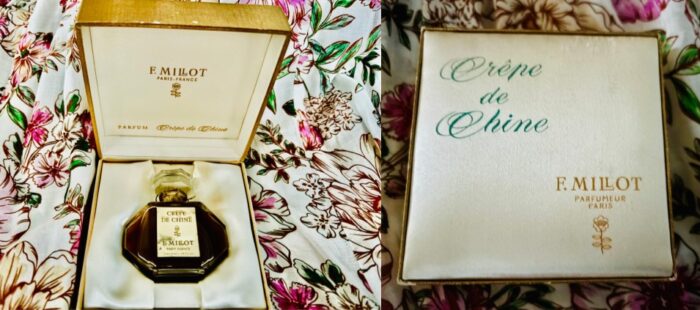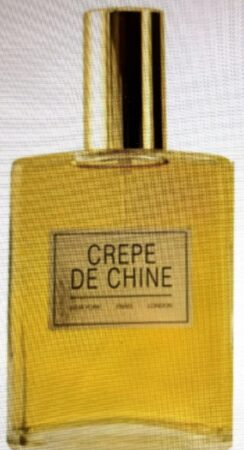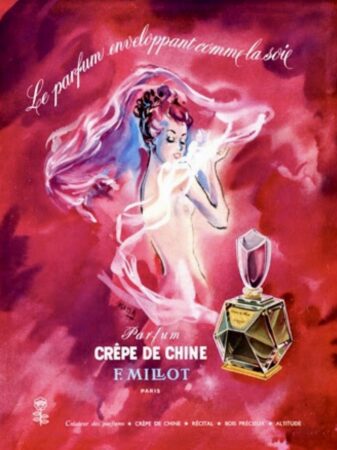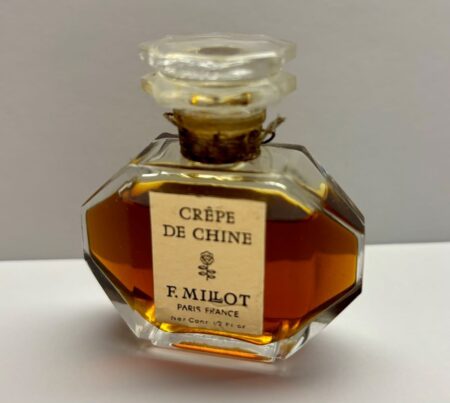
Ida’s bottle of F. Millot Crêpe de Chine and cover collage©
I am besotted with scent; it’s an inescapable truth: in this respect, I consider myself an unrepentant sinner. Perfume is (hands down) my greatest indulgence. As you may be aware, I cut my milk teeth on chypres (all the women I was close to in my childhood wore them) – and they remain perhaps those perfumes which are dearest to my heart. Their depth, complexity, and profound mystery sing an irresistible siren song in my ear and on my skin – and blessed be, there is no dearth of chypres to be had. By studying the past, we are led to a richer understanding of how perfumery has evolved: one pivotal example that I would like to share with you is 1925’s exquisite green aldehydic chypre Crêpe de Chine, created for F. Millot, the founder of Parfums Millot, by his great-grandson Jean Desprez. This fragrance was named after the newly-touted smooth, light, lustrous wrinkle-resistant silk fabric first displayed at the 1925 Art Deco Exhibition in Paris.

Jean Desprez public domain and apped
F. Millot Crêpe de Chine is the culmination of three talented individuals: Marius Reboul of Givaudan, considered one of the greatest perfumers of all time, to whom Jean Desprez was apprenticed; Jean Desprez himself; and polymath French architect/designer Hector Guimard – who created myriad art forms, be it perfume flacons, edifices, interiors, textiles, jewelry, or bespoke garments.

1925 Jean Charles Worth dress via Metropolitan Museum
Jean Desprez created Crêpe de Chine in 1925, but he did not establish his own house Parfums Desprez until 1939. We remember him most fondly for his magnificent Bal à Versailles, which was composed in 1962, 37 years later. His Givaudan mentor, Marius Reboul, is one of those people whose name isn’t frequently bandied about, despite his achievements which altered the face of Parisian perfumery. Reboul created bases and specialties for Givaudan which were, and continue to be – much sought after and employed by famous perfumers. One example was his Muguet 16 (still in production), which has been copied by many companies; Amarante, utilized to great effect in Henri Alméras’ Amour Amour for Jean Patou (Patou’s Ma Collection); Cetonia, a powerful ionone-rich compound considered by many to be comparable to/better than Firmenich’s famed Iralia® (created in 1903); Sophora (now restored as Sophira) – an intense vetiver and cedar base which was included in Reboul’s Un Air Enbaumé for Rigaud; and Lily 7, a major component of Madame Zed’s Arpège for Jeanne Lanvin.

Ida’s image of F. Millot Crêpe de Chine Long-Lost Perfumes reconstruction (discontinued)
The Osmothèque’s founder Jean Kerléo has credited F. Millot Crêpe de Chine as being the first fragrance in their archive. Since then, Parfums Millot was acquired by Revillon in 1963, and discontinued Crêpe de Chine in 1968. I cannot uncover when the cosmetics company Irma Shorell acquired its formula for her now-defunct Long-Lost Perfumes – a brand which bought both the names and formulae for several discontinued classic fragrances. Some of these reconstructions are more successful than others in capturing the spirit of the originals – and Crêpe de Chine is one of the better iterations. Today, one is far more likely to access the original than the remake (it’s extremely scarce), ironically – yet another idiosyncrasy of the perfume community.

Vintage poster by Masa 1940 public domain
So, when did my fascination for this pivotal chypre begin? I was in junior high school, and a lanky, beautiful geeky blonde 3 years my senior carried it in her school bag – along with various trowels. Yes, trowels. Shelley wanted nothing more than to become an archeologist (I still drool with longing just thinking about it!) – and I revered her; she had already gone on a few digs in exotic locales. Her future was sewn up and tied with a silk ribbon, in my eyes – and she wafted a mossy perfume which trailed her everywhere. When you’re the sort of person who spends as much time as possible out of doors in moss-covered, sylvan settings, you notice this sort of thing. I rummaged around in her bag when she wasn’t looking, just so I could huff her Crêpe de Chine (and like other proper young ladies in the 60s, she owned the eau de toilette, not the parfum). These intertwined memories are still ardent today – and as I sat down to write and opened my well-preserved ½ oz. of F. Millot Crêpe de Chine, they all came flooding back.

Ida’s F. Millot Crêpe de Chine flacon
When the German Lutheran pastor and poet Eduard Mőrike wrote: “If you love for beauty, do not love me!”, he certainly wasn’t describing F. Millot Crêpe de Chine. Beauty is its nature, and it waxes optimistic, moody, and contemplative by turns. In keeping with the custom of the day, scintillating citrus and aldehydes announce this chypre’s arrival, trailed by deliciously herbal basil and chamomile. Its floral heart is brimful, a riotous bouquet of spicy, indolic elements (gardenia, ylang-ylang, carnation, lilac, jasmine) caressed by a lovely rose otto. Blossoms on the verge of divine decay mingle with eugenol-laden carnation; it fills the heart with unbridled joy. The supporting characters contribute mood and further nuance: silky nitromusks of yore, precious sandalwood, ancient resins (Peru balsam, benzoin); a dollop of woody vanilla; balsamic, smoke-kissed vetiver, and the dusky earthiness of oakmoss, patchouli and labdanum. There’s no stinting the best of the best – and it is this generous usage of quality olfactory materials in the hands of a master which sets Crêpe de Chine apart from the fragrant herd. It is a wearable enigma whose elegance never goes out of fashion, and although it is no longer in production, there are many available bottles on eBay- including minis, which tend to be affordable – especially in miniature sizes.
Notes: neroli, Italian bergamot, lemon, orange, Egyptian basil, oil of Peru, aldehydes, gardenia, ylang-ylang, carnation, lilac, rose oil, Roman chamomile, Egyptian jasmine, sandalwood, musk, oakmoss, vanilla, vetiver, benzoin, labdanum, Indonesian patchouli
Bottles displayed were purchased by me, from my own collection. My nose is my own…
Ida Meister, Deputy and Natural Perfumery Editor
Please follow us on Instagram @cafleurebonofficial @idameister
This is our Privacy Policy
